Chimney Sweeps and Asbestos
Chimney sweeps are at risk of asbestos exposure when servicing old fireplaces that have an asbestos chimney liner, an asbestos pipe or asbestos brick and mortar. Exposure to asbestos fibers can cause mesothelioma, lung cancer and other forms of cancer.
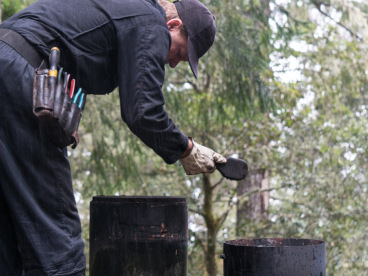
Written by Michelle Whitmer • Edited By Walter Pacheco • Scientifically Reviewed By Yvonne Waterman
Asbestos.com is the nation’s most trusted mesothelioma resource
The Mesothelioma Center at Asbestos.com has provided patients and their loved ones the most updated and reliable information on mesothelioma and asbestos exposure since 2006.
Our team of Patient Advocates includes a medical doctor, a registered nurse, health services administrators, veterans, VA-accredited Claims Agents, an oncology patient navigator and hospice care expert. Their combined expertise means we help any mesothelioma patient or loved one through every step of their cancer journey.
More than 30 contributors, including mesothelioma doctors, survivors, health care professionals and other experts, have peer-reviewed our website and written unique research-driven articles to ensure you get the highest-quality medical and health information.
About The Mesothelioma Center at Asbestos.com
- Assisting mesothelioma patients and their loved ones since 2006.
- Helps more than 50% of mesothelioma patients diagnosed annually in the U.S.
- A+ rating from the Better Business Bureau.
- 5-star reviewed mesothelioma and support organization.
Testimonials
My family has only the highest compliment for the assistance and support that we received from The Mesothelioma Center. This is a staff of compassionate and knowledgeable individuals who respect what your family is experiencing and who go the extra mile to make an unfortunate diagnosis less stressful. Information and assistance were provided by The Mesothelioma Center at no cost to our family.LashawnMesothelioma patient’s daughter
How to Cite Asbestos.com’s Article
APA
Whitmer, M. (2023, June 20). Chimney Sweeps and Asbestos. Asbestos.com. Retrieved April 18, 2024, from https://www.asbestos.com/occupations/chimney-sweep/
MLA
Whitmer, Michelle. "Chimney Sweeps and Asbestos." Asbestos.com, 20 Jun 2023, https://www.asbestos.com/occupations/chimney-sweep/.
Chicago
Whitmer, Michelle. "Chimney Sweeps and Asbestos." Asbestos.com. Last modified June 20, 2023. https://www.asbestos.com/occupations/chimney-sweep/.
How Were Chimney Sweeps Exposed to Asbestos?
Fireplaces built before the 1990s can contain asbestos in the hearth, firebox, chimney and flue. Fireplaces may also contain artificial gas logs, ashes and embers contaminated with asbestos if built prior to 1978. Chimney sweeps who service these fireplaces may encounter asbestos-containing materials when performing cleaning or maintenance.
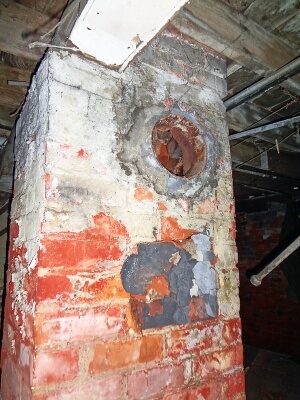
The occupational asbestos exposure that chimney sweeps encounter has caused them to develop cancers such as mesothelioma and lung cancer.
Chimney sweeps are advised to wear respiratory protection to reduce their exposure to toxic substances. Ordinary dust masks and filtering facepiece respirators do not sufficiently filter out microscopic asbestos fibers. The Occupational Safety & Health Administration recommends a respirator with a high-efficiency particulate air filter for workers who may encounter asbestos.
Chimney sweeps should also follow safety protocols to clean their work clothes, shoes and tools. This safety measure can prevent chimney sweeps from bringing asbestos home. Workers involved in asbestos chimney removal should also wear a HEPA-fitted respirator and follow safety protocols to clean their work clothes.
Asbestos Products Associated with Chimney Sweeps
There are two types of fireplaces: Masonry and prefabricated. Masonry fireplaces are constructed by builders, bricklayers or masonry workers and are typically made of firebrick, which used to contain asbestos. Masonry fireplaces may contain several different products containing asbestos such as cement, firebrick, mortar and insulation.
Prefabricated fireplaces are made in a factory out of metal. They are slightly less likely to contain asbestos, but the hearths might be covered with noncombustible materials such as asbestos, brick, iron or steel. Prefabricated chimneys were commonly lined on the outside with asbestos insulation after being fitted to the home. These chimneys are found in homes built after the 1950s.
Chimney sweeps may encounter the following asbestos products:
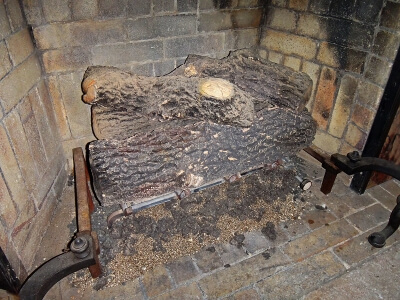
- Artificial Ash and Embers
These materials contained asbestos until 1977 when the U.S. Consumer Product Safety Commission banned asbestos in artificial ash and embers.
- Artificial Gas Logs
This product may have been made with artificial ash and embers until the 1977 ban.
- Asbestos Flue
A flue is a vent, pipe or opening in a chimney stack that exhausts gases from fireplaces. Different types of flues contain a variety of asbestos products. For example, asbestos cement pipes served as chimney flues. Other flues were made with brick or stone.
- Asbestos Paper Plies
Fireplaces, including the chimneys, were sometimes lined on the outside with asbestos paper plies as a form of protective insulation. This insulation protected the house from heat transfer to combustible materials and appliances.
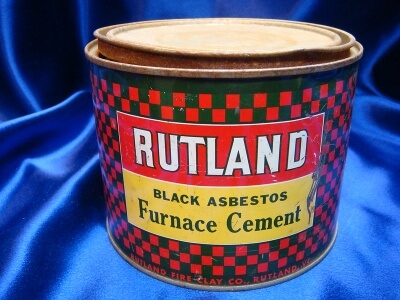
- Cement
Asbestos cement, also known as refractory cement, was used to line chimneys and furnaces, manufacture flues, install chimneys and make patches in damaged chimneys. Asbestos-containing roof cement was used to adhere the chimney to the roof. Transite is a brand name of asbestos cement made by Johns Manville that was widely used in chimneys.
- Firebrick
Bricks were once made with asbestos to make them fireproof for use in chimneys and fireplaces.
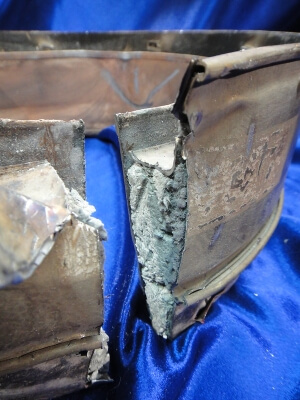
- Fireplace Inserts
Fireplace inserts were also made with asbestos. A fireplace insert is essentially a stove that burns wood or gas and is designed to be inserted into an existing fireplace. Asbestos insulation material was used inside and outside of fireplace inserts. Some gas fireplaces used tufts of asbestos fibers to support the heating flame.
- Insulation
Insulation used around fireplaces and on the exterior of prefabricated chimneys contained asbestos through the 1980s. Some chimney and fireplace asbestos insulation was called wall covering or board.
- Mortar
Mortar used to hold firebrick together also contained asbestos to prevent fires from developing in the chimney.

Manufacturers of Asbestos Fireplace Products Chimney Sweeps Encounter
Certain asbestos products used by chimney sweeps became known by their brand names, including Transite, a type of asbestos cement manufactured by Johns Manville. It became so popular that the brand name became synonymous with any similar material.
Transite was made with 10% to 50% asbestos up until the 1980s, when it was phased out of the product. Chimney sweeps who serviced fireplaces built before the 1980s may have been exposed to transite asbestos cement in chimneys. This product was not banned or recalled and may have been used into the 1990s to construct fireplaces.
The following companies manufactured asbestos products encountered by chimney sweeps:
- Dresser Industries Inc.: This company made asbestos-containing firebrick under brands names such as Metalkase Firebrick and Nucon Firebrick. It also made Micacrete Refractory Cement with asbestos.
- Johns Manville: Johns Manville made asbestos cement widely used by chimney sweeps.
- GAF/Ruberoid: This company made an asbestos-containing fireplace insulation known as Hearth-Glow Brick Boards and asbestos-containing artificial brick wallpaper called Brick-Strip Paper.
- General Refractories Company: General Refractories made firebrick with asbestos known as Steelklad Dibond Firebrick.
- H.K. Porter: This company made Bonding Mortar Ho. 20 that contained asbestos.
- National Gypsum: National Gypsum made Gold Bond Mortar Mix that contained asbestos.
- Nebel Products Manufacturing Co.: Nebel made asbestos furnace cement that was used to install chimney collars to protect the chimney from storms and debris.
- Rutland: This company made black asbestos furnace cement.
- Selkirk Metalbestos: Selkirk made a prefabricated chimney containing asbestos.
- Sherwin-Williams Paint Company: This widely known company made a type of mortar called Brick and Stucco Buff that contained asbestos.
- United States Gypsum: This company made Pyrobar Mortar Mix that contained asbestos.
- Van-Packer Company: Van-Packer, a division of the Flintkote Company, made asbestos cement insulation used in chimneys.

Chimney Sweeps and Mesothelioma
At least one study has reported on mesothelioma in chimney sweeps. A 2013 study showed an increased incidence of pleural mesothelioma in Swedish chimney sweeps. The incidence was highest among chimney sweeps who worked the job long-term. This study also found an increased incidence of lung cancer among chimney sweeps and attributed the increase to exposure to carcinogens such as asbestos, arsenic and polycyclic aromatic hydrocarbons.
More scientific studies have been conducted on asbestos exposure among the workers who build fireplaces — including brick masons, bricklayers and masonry workers — compared to the workers who clean them.
Several studies have reported on the increased incidence of asbestos-related disease among the workers who build fireplaces. According to a 2022 report by the European Commission, over 70,000 workers died in 2019 from past exposure to asbestos.
- A study of construction workers in North Carolina found an elevated risk of lung cancer among brick masons.
- An asbestos exposure study in British Columbia found an increased incidence of mesothelioma among bricklayers.
- Researchers followed Swedish bricklayers from 1961 to 1998 and found an increased risk of pleural mesothelioma in the population.
- A study of 10,400 members of the International Union of Bricklayers and Allied Craftsmen between 1986 and 1991 found an increase in deaths from lung cancer and asbestosis.
Those who made the asbestos products encountered by chimney sweeps were directly exposed to asbestos during the manufacturing process. Factory workers who made prefabricated chimneys, firebricks, artificial ash and embers, insulation and mortar were exposed to high levels of asbestos dust.
Exposure to asbestos is known to cause mesothelioma, lung cancer, ovarian cancer, laryngeal cancer and asbestosis. If you are diagnosed with one of these conditions, it is important to work with a doctor specializing in your diagnosis. Many of these specialists work at the nation’s top cancer centers.
Legal Options for Chimney Sweeps Exposed to Asbestos
Asbestos use in fireplaces and chimneys was phased out in the 1970s and 1980s. In 1977, the U.S. Consumer Product Safety Commission banned asbestos-containing artificial fireplace ash and embers. The ban included gas logs frosted with the artificial ash.
Other asbestos materials in fireplaces were phased out without bans because the public was becoming aware of the dangers of asbestos exposure and companies wanted to avoid liability.
Chimney sweeps who develop mesothelioma or other asbestos-related diseases were likely exposed to asbestos products on the job. Workers who develop asbestos-related diseases as a result of occupational asbestos exposure have the option of filing a personal injury lawsuit against the manufacturers who made the products they were exposed to.
They may also file claims with certain asbestos trust funds, depending on past exposure. Close family members who lose a loved one to mesothelioma or lung cancer may file a wrongful death lawsuit.
A qualified mesothelioma attorney has the expertise to guide you on the types of claims you may qualify to file. Some people qualify to file a lawsuit and multiple claims with asbestos trust funds to access more compensation to cover medical costs and lost wages.







